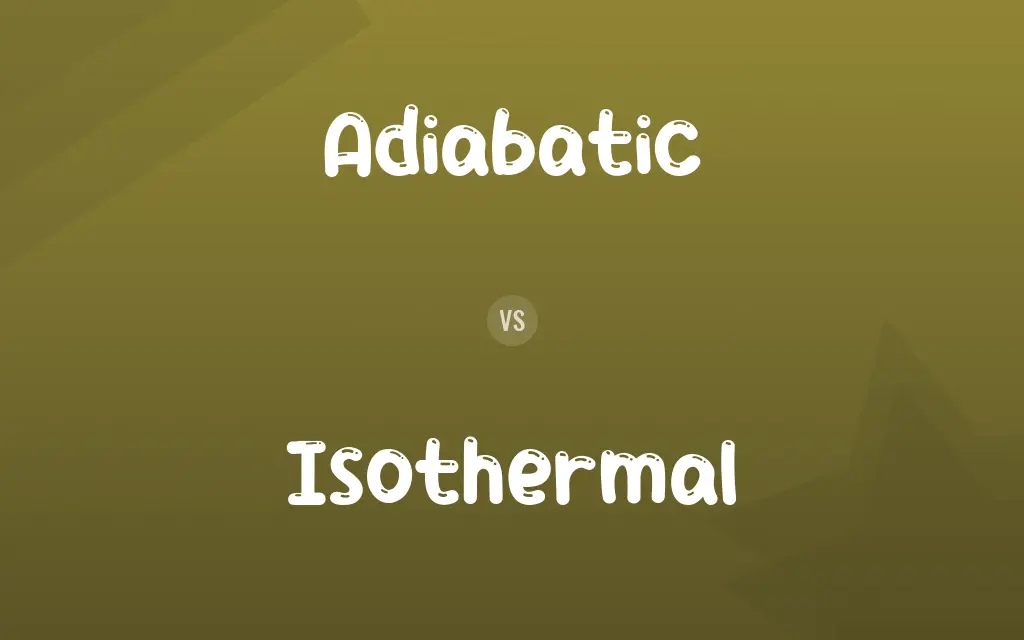Adiabatic vs. Isothermal: Difference and Comparison
Edited by Muazma Batool — By Muneeza Rehman — Published on February 13, 2024
Adiabatic processes occur without heat transfer, while isothermal processes happen at constant temperature.

Difference Between Adiabatic and Isothermal
Adiabatic and isothermal are terms used in thermodynamics to describe different types of processes based on how they handle heat. An adiabatic process refers to scenarios where no heat is exchanged between a system and its surroundings. This means that any change in the internal energy of the system is due solely to work done by or on the system. In contrast, isothermal processes occur at a constant temperature. This implies that heat can be transferred between the system and its surroundings, but the overall temperature remains unchanged.
Muneeza Rehman
Feb 13, 2024
For instance, consider a gas enclosed in a piston. If this gas is compressed quickly without allowing it to exchange heat with its environment, it would be an adiabatic process. The temperature of the gas might rise, but no heat is gained or lost from the system. On the other hand, if the gas is compressed slowly while maintaining a constant temperature by allowing heat exchange, it undergoes an isothermal process.
Muazma Batool
Feb 13, 2024
One notable outcome of an adiabatic process is the adiabatic flame temperature. It is the temperature achieved when a fuel is burned without any heat being lost to the surroundings. The concept contrasts with isothermal scenarios where processes, such as chemical reactions, can proceed while maintaining a constant temperature by either absorbing or releasing heat.
Muneeza Rehman
Feb 13, 2024
In summary, the distinction between adiabatic and isothermal lies in how they interact with heat. Adiabatic processes don't exchange heat, leading to changes in temperature based on the work done. Isothermal processes, while exchanging heat, maintain a constant temperature throughout.
Levi
Feb 13, 2024
Adiabatic vs. Isothermal Definitions
◉Adiabatic
A process without heat exchange.
The rapid expansion of a gas in a piston can be adiabatic.
Muazma Batool
Sep 25, 2023
◉Isothermal
A process at constant temperature.
Melting ice at 0°C is an isothermal change.
William
Sep 25, 2023
◉Adiabatic
A condition with no heat gain or loss.
Adiabatic walls prevent any heat transfer.
William
Sep 25, 2023
◉Isothermal
Describes systems maintaining their temperature during processes.
Water boiling at 100°C at 1 atm is an isothermal transformation.
Muneeza Rehman
Sep 25, 2023
◉Adiabatic
Referring to changes in temperature without heat transfer.
Adiabatic cooling occurs when air rises and expands.
Olivia
Sep 25, 2023
◉Isothermal
Referring to uniform temperature throughout.
An isothermal chamber maintains a steady temperature inside.
Muazma Batool
Sep 25, 2023
◉Adiabatic
Thermodynamic changes solely due to work.
The adiabatic compression of a gas increases its temperature.
Lucas
Sep 25, 2023
◉Isothermal
Thermodynamic changes with heat transfer maintaining temperature.
Slow compression of a gas can be isothermal if heat is exchanged.
Nolan
Sep 25, 2023
◉Adiabatic
Describes a system isolated from heat exchange.
Adiabatic processes are idealizations in thermodynamics.
Muneeza Rehman
Sep 25, 2023
◉Isothermal
A condition where temperature doesn't change despite heat exchange.
Isothermal reactions can release or absorb heat without changing temperature.
Henry
Sep 25, 2023
◉Adiabatic
Of, relating to, or being a reversible thermodynamic process that occurs without gain or loss of heat and without a change in entropy.
Muneeza Rehman
Sep 24, 2023
◉Adiabatic
That occurs without gain or loss of heat (and thus with no change in entropy, in the quasistatic approximation).
Muneeza Rehman
Sep 24, 2023
◉Isothermal
Of or designating changes of pressure and volume at constant temperature.
Muneeza Rehman
Sep 24, 2023
◉Adiabatic
That involves the slow change of the Hamiltonian of a system from its initial value to a final value.
Muneeza Rehman
Sep 24, 2023
◉Isothermal
Of or pertaining to a process that takes place at constant temperature
Muneeza Rehman
Sep 24, 2023
Adiabatic vs. Isothermal Frequently Asked Questions
Is boiling water at a constant pressure an isothermal process?
Yes, as the water maintains a constant temperature during boiling.
Nolan
Feb 13, 2024
What happens to a gas's temperature during adiabatic compression?
It generally increases due to the work done on the gas.
William
Feb 13, 2024
What does adiabatic mean in thermodynamics?
It refers to processes without heat exchange.
Muneeza Rehman
Feb 13, 2024
How does an isothermal process maintain its temperature?
By allowing heat exchange with the surroundings.
Muazma Batool
Feb 13, 2024
Why is the adiabatic flame temperature significant?
It represents the maximum temperature a fuel can achieve when burned without heat loss.
Muneeza Rehman
Feb 13, 2024
Is it correct to say an adiabatic process is always faster than isothermal?
Not always, but rapid processes often tend toward adiabatic conditions due to limited time for heat exchange.
Muneeza Rehman
Feb 13, 2024
Can an adiabatic process change the temperature of a system?
Yes, temperature can change in adiabatic processes due to work.
Muneeza Rehman
Feb 13, 2024
Do real-world processes strictly follow adiabatic or isothermal conditions?
Rarely, as real-world scenarios often have some heat loss or gain.
Leo
Feb 13, 2024
How can one achieve an isothermal process in a lab setting?
By using controlled environments like water baths to maintain temperature.
Muazma Batool
Feb 13, 2024
How do adiabatic and isothermal processes differ in energy conservation?
In adiabatic, energy changes are due to work, while isothermal can involve both heat and work.
Nolan
Feb 13, 2024
Content Creators
Written by
Muneeza RehmanAt Comparisons.wiki, Muneeza skillfully navigates the vast sea of information, ensuring clarity and accuracy as the lead content editor. With a keen eye for detail, she curates every comparison to enlighten and engage readers.
Edited by
Muazma BatoolAs a content editor, Muazma Batool is not just a grammar guru but a creative mastermind who breathes life into every word. With an eagle eye for detail and a passion for storytelling, she transforms bland text into engaging content that captivates audiences and drives results.





























